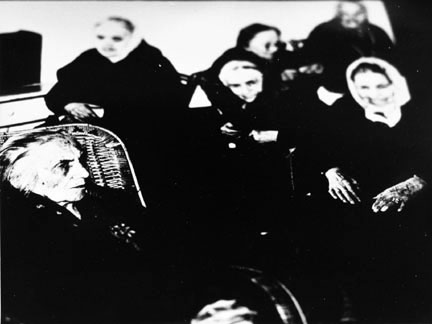About the Photographer
Giacomelli, Mario
Italian, 1925-2000
Working in discrete photographic series, Giacomelli focuses on subjects that invite a socio-political interpretation, such as the ailing residents of a hospice or a marginalized gypsy community. Nevertheless, he conceives his photographs as mixtures of reality and artifice, as artistic inventions rather than documents. Transcending their ostensible topics, Giacomelli's series are underwritten by a more universal fascination with the mysteries and blunt realities of death and aging; he thinks of his work as mirroring what he sees inside himself.
The MoCP holds selections from four of Giacomelli's photographic series in its permanent collection. The earliest is from Lourdes, completed in 1957 in the French town of the same name, which has been a Christian pilgrimage site for a hundred and fifty years. Giacomelli photographed masses of ill and dying people in wheelchairs and stretchers as they queued up outside of the shrine with hopes of being healed. With the exception of his visit to Lourdes and a few other trips, Giacomelli made his photographs almost entirely in the vicinity of his hometown, Senigallia. The photographs in the series Verrà la Morte e Avrà i Tuoi Occhi (Death Will Come and It Will Have Your Eyes) were taken at a hospice in the area between 1956 and 1983. Contrasting with the sick at Lourdes, who hoped to evade death through miraculous healing, the home's moribund residents--whom Giacomelli portrays with unsentimental candor as they go about their activities--represent another side of the human relationship with death.
Perhaps due his beginnings as a painter and his profession as a typesetter, Giacomelli consistently disrupts the clarity of the photographic image when printing in the darkroom, giving it a stronger graphic impact and an expressive sense of atmosphere. He typically heightens the contrast in his photographs, yielding deep blacks and bright whites at the expense of the mid-tones, and in some series he deliberately makes use of blurring and the film's grain. These formal techniques are particularly central to his images from the Scanno series, made in Southern Italy. Emphasizing Scanno's seemingly timeless existence as a "fairytale village of simple people," as he puts it, Giacomelli accentuates "the beautiful contrasts of… white streets and black figures, white walls and black cloaks." An interest in overlooked communities and Italian street life resurfaces in Giacomelli's photographs of a gypsy camp near Senigallia, from the Zingara series. Shot in a mere half hour in 1958, the Zingara series focuses primarily on the children in the camp. In one key image, two children strike adult poses, a boy gripping a cane with a posture of male authority while a young girl beside him holds a baby on her hip with a self-assured smile.
Born in Senigallia, Italy, Mario Giacomelli began painting and writing poetry at a young age. He stopped attending school at the age of thirteen to work as a typesetter. In 1944, he became the owner of a printing shop, which would be his primary source of income for most of his life. Giacomelli bought his first camera in 1954, and studied briefly with photographer Guiseppe Cavalli. Giacomelli exhibited extensively in Europe and the United States. Included among his numerous publications are the monographs Giacomelli: The Interior Shape (2001), Mario Giacomelli: Evoking Shadow (2002), and The Black Figure is Waiting for the White (2009).




